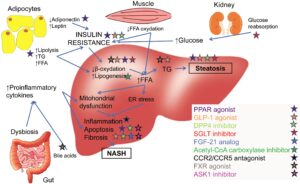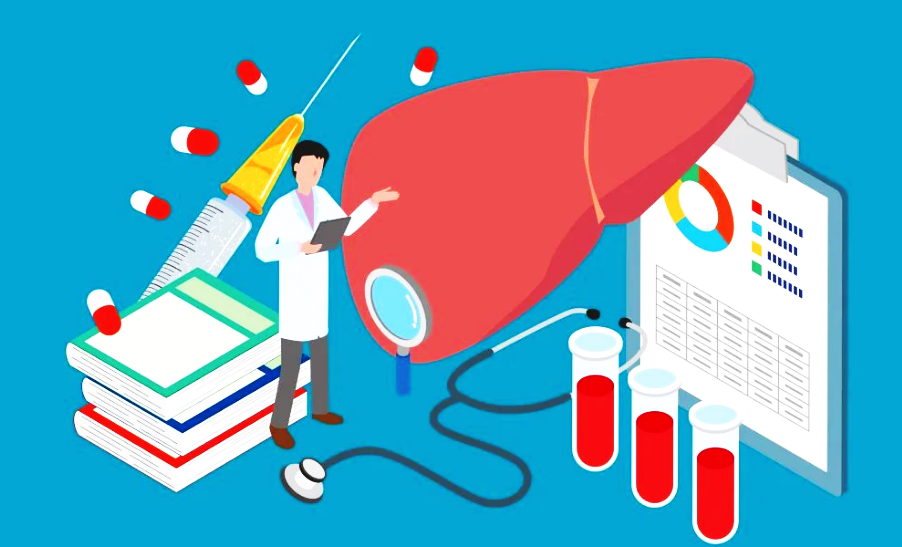What is NASH?
Nonalcoholic Steatohepatitis (NASH) is a complex liver condition identified by the buildup of fat, inflammation, and damage to liver cells. It impacts millions worldwide, especially individuals who do not drink much alcohol, setting it apart from alcoholic liver disease. NASH frequently arises from a milder condition called nonalcoholic fatty liver disease (NAFLD), which involves only fat buildup in the liver without notable inflammation or cell harm. If unchecked, NASH can progress to cirrhosis, liver failure, and even liver cancer. Understanding the NASH model is crucial for medical professionals diagnosing and treating this ailment. This model offers a framework for conceptualizing how NASH develops and progresses and provides insights into potential treatment strategies and preventive measures. By thoroughly understanding the NASH model, researchers and clinicians can devise more targeted and effective interventions, potentially halting the disease.

Symptoms and Diagnosis
Diagnosing NASH can pose challenges as it frequently remains asymptomatic in the early stages. Many patients exhibit either minimal symptoms that go unnoticed or no symptoms at all. Some possible symptoms to look out for are constant fatigue, pain in the upper right abdomen, and sudden unexplained weight loss. Unfortunately, many patients only receive a diagnosis when their condition has progressed to severe stages such as cirrhosis.
Doctors use a blend of diagnostic methods to pinpoint NASH effectively. Imaging techniques such as ultrasounds, CT scans, and MRIs can show the size of fat accumulations and liver injury. Blood tests measuring liver enzyme levels are frequently done along with imaging techniques to understand the significance of liver inflammation. In some cases, healthcare providers might recommend a liver biopsy, which includes extracting a tiny portion of liver tissue for examination in a lab. This biopsy assesses inflammation and fibrosis levels, ultimately offering a definitive diagnosis.
Current Treatment Options
Successfully managing NASH requires a comprehensive plan that addresses lifestyle modifications and medical therapies. Key strategies involve major changes in diet and physical activity. The first recommendation is often to lose weight through a healthy diet and exercise, as this can significantly reduce liver fat and inflammation.
A diverse range of fruits, vegetables, whole grains, and lean proteins can significantly impact.
Pharmacological therapies are also showing advantages. Certain medications focus on addressing insulin resistance, which is a prevalent problem in NASH patients, whereas others aid in controlling high cholesterol levels and decreasing inflammation. Furthermore, novel medications are being developed that target the particular biological mechanisms associated with NASH. Proper management of issues such as obesity, diabetes, and high levels of fat in the blood is crucial in halting the advancement of NASH.
The Role of NASH Research
The ongoing research in the field of NASH is pivotal in unlocking new treatment avenues and understanding the disease’s underlying mechanisms. Scientists are delving into the genetic and environmental contributors to NASH, aiming to enhance early detection and accelerate the development of targeted treatments. Research into the genetic malfunction and the environmental triggers of the disease offers a holistic view, facilitating the development of multifaceted treatment plans.
Additionally, research into novel biomarkers provides hope for better diagnostic tools. By identifying these biomarkers, healthcare providers can predict the disease’s progression more accurately and intervene at earlier stages, ultimately improving patient outcomes. Such biomarkers can be detected through non-invasive tests, sparing patients from the discomfort and risks associated with liver biopsies. As research continues to evolve, these biomarkers are expected to revolutionize how NASH is diagnosed and treated.
Latest Developments in NASH
Recent advancements in NASH research have been promising, with new therapeutic compounds and innovative treatment modalities emerging from clinical trials. The development of anti-fibrotic agents aims to halt or even reverse liver fibrosis, a severe consequence of persistent NASH. Metabolic modulators, another promising category of drugs, work by altering the metabolic pathways involved in the disease, thus addressing the root causes of NASH.
These cutting-edge therapies align with current goals to find practical solutions for this challenging condition. Integrating multidisciplinary approaches, combining clinical expertise in hepatology, endocrinology, and pharmacology with advanced technologies like genomics and computational biology, has further accelerated the pace of discovery
Future Directions and Innovations
The future of NASH treatment looks increasingly optimistic, bolstered by ongoing research and technological advancements. Personalized medicine is one promising area, with researchers striving to tailor treatments based on individual genetic profiles and disease characteristics. By focusing on the genetic underpinnings of NASH, scientists aim to develop highly effective treatments that minimize adverse effects.
Initiatives are also in progress to develop medications that target the pathways associated with the advancement of NASH. These advanced therapies guarantee to provide more accurate treatments, minimize side effects, and enhance patient adherence. As our knowledge of these pathways increases, medical professionals can better anticipate which patients will benefit most from specific treatments, leading to personalized and proactive care plans.
Patient Support and Resources
Patients diagnosed with NASH have access to a wealth of resources designed to aid in disease management and improve quality of life. Nutritional counseling and dietitians can provide personalized dietary plans that help manage liver health more effectively. Support groups offer a community environment where patients can share experiences and coping strategies, reducing the emotional burden of the disease.
Mental health services are also crucial, as the psychological impact of chronic disease should not be underestimated. Patient advocacy groups frequently offer extensive educational resources and can assist patients in navigating the healthcare system more efficiently. By utilizing these diverse resources, individuals acquire the necessary tools and assistance to take a proactive approach to managing their condition, ultimately improving their overall health.


